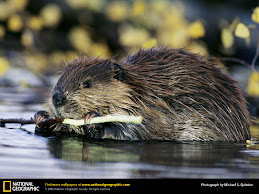There's a massive sugar maple turning an extraordinary red-orange not far from my house. You’ve got to see this one—sugar maples are among the area’s showiest fall colors anyway (photo below), and this is one of the best sugar maples I’ve ever seen. In fact, the sugar maple color is so unique it belongs in a Crayola crayo n box.
n box.
Tuliptrees, the largest trees in local forests, are busily brightening yellow, dogwoods slide into a beautiful deep burgundy, sassafras glows bronzy orange with hints of purple, and believe it or not, poison ivy turns the purest red in nature’s fall palette. Each tree turns its own characteristic color in the fall season.
But even as the trees complete this miracle, something else happens to their leaves: they drop. It’s why we call it fall. Between now and the end of the year, we’ll fill uncountable numbers of big brown leaf bags. It is simply amazing— discouraging, even—how many leaves fall from a single tree.
So by Thanksgiving, we’re sick of leaves, sick of raking, sick of the unending dreary brown of dead leaves that cover the landscape. And for many of us, the neatening genes kick in, and we want to gather and get rid of all those wet, decomposing leaves that suffocate our suburban lawns.
But wait.
This year, I invite you to join me in a very special, almost anarchic, act: rake less leaves this fall. Leave piles of leaves in corners or sections of your lawn and garden, if you can. For two reasons, one more obvious than the other.
More obvious: those leaves falling off your trees are filled with the exact nutrients in the perfect combinations that your lawns need as nutrition. Amazingly, we pay people to blow every leaf off our precious green lawn, then pay someone else to pour buckets of nutrient-rich fertilizers onto those same nutrient-starved lawns, most of which runs off the property when the first rainfall comes anyway. We burn a lot of bucks this way.
We’d save tons of time, energy and money if the nutrients stored in those leaves were simply put back directly where they belong—on your lawn. Use a mulching mower to chop them (much more effective when the leaves are dry than wet), and leave them in place. The small particles of leaves will happily decompose into your lawn—and feed your grass. Some people compost their leaves, which is also fine—but few then use the resulting compost. Mulching in place saves incredible amounts of precious energy while feeding the lawn organically, skipping fertilizers made from petrochemicals.
Mulching promotes energy conservation and cools the climate.
Less obvious reason: yesterday, I spotted a Monarch butterfly flitting across a meadow. Normally a happy sight, seeing one this late in the fall made me sad—Monarchs overwinter in Mexican mountain valleys, and as the first Monarchs usually show up in Mexico around Halloween, this dude should have been much farther south by now, and I don’t think it’s going to reach Mexico for the winter.
But countless other insects like beetles, wasps, bees and butterflies—the same creatures that literally hold up the world—hibernate in one stage of their life cycle, tucked away in nooks and crannies of our fields and forests. Many burrow beneath piles of leaves, using them as blankets of insulation, and sleep the winter away. Ladybugs hibernate as larvae, praying mantises as egg cases, tiger swallowtails as cocoons: each insect survives the winter in only one stage of its life cycle, and each insect has picked a different stage.
So when landscapers leaf-blow our gardens, or when we meticulously rake every leaf off our lawns, we are disturbing and even killing countless numbers of overwintering insects, trucking them off to the leaf dump to be buried beneath tons of debris. And there is a cost.
Fireflies, for example, are becoming increasingly rare in American suburbs, partly because of too much light at night—they can’t see each other with all our security lights—and partly because too many lawns are too well manicured. They have no place to overwinter.
While it drives one of my daughters crazy, I am deliberately a lazy gardener, leaving corners and beds loaded with leaves, Mother Nature’s mulch, not raking them up but letting them be. They slowly decompose during the winter, slowly releasing their nutrients into my flower beds, providing sleeping places for butterflies, bees and bugs.
Messy gardening promotes biological diversity.
With all our discussions about living green, there are so many actions you can take, from aggressively recycling to purchasing an electric car. But also on the list is changing our gardening habits. So leave those leaves, wherever you can, conserving energy and allowing creatures great and small their winter hiding places.


No comments:
Post a Comment